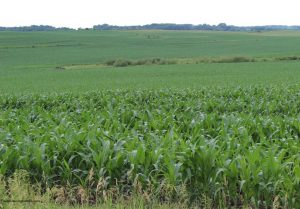E. coli from cattle feed lots can blow into neighboring fields and contaminate produce, according to a new study. The finding raises the question if setback distance between cattle feedlots and produce fields should be adjusted to improve food safety.
 The two-year study was conducted by researchers from the U. S. Department of Agriculture, Agricultural Research Service, U.S. Meat Animal Research Center, Clay Center, Nebraska; the Department of Plant Sciences, University of California, Davis, California; and the U. S. Department of Agriculture, Agricultural Research Service, Beltsville Agricultural Research Center, Beltsville, Maryland. It appears in the December issue of Applied and Environmental Microbiology
The two-year study was conducted by researchers from the U. S. Department of Agriculture, Agricultural Research Service, U.S. Meat Animal Research Center, Clay Center, Nebraska; the Department of Plant Sciences, University of California, Davis, California; and the U. S. Department of Agriculture, Agricultural Research Service, Beltsville Agricultural Research Center, Beltsville, Maryland. It appears in the December issue of Applied and Environmental Microbiology
In both years, leafy greens were planted to nine plots located 60, 120, and 180 meters from a cattle feedlot. Each year, samples were collected six times from June to September and tested for E.coli O157:H7. In all, 270 samples were collected from the greens and 100 samples were collected from the manure.
In samples from all distances, researchers found E. coli O157:H7 and total E. coli. But proximity to the feedlot was a factor. For example, researchers found E. coli O157:H7 in 3.5 percent of leafy green samples form the 60 meter plot, a higher percentage than the 1.8 percent of positive samples the detected from the 180 meter plot.
E. coli O157:H7 was not recovered from air samples at any distance, but total E. coli was recovered from air samples at all plot distances. Researchers say this indicates that E.coli can be transported through the air. They also found that more E. coli was likely to be transported in dry conditions or when cattle behaviors kicked up dust.
Researchers say their findings suggest that the current 120 meter setback distance between feedlots and leafy green fields may not be adequate to prevent the transmission of E.coli O157:H7.




